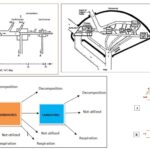1. Briefly explain why you should not heat organic solvents over a Bunsen burner flame. 2. Indicate a procedure to solve the following recrystallization problems. (a) oiling out (b) lack of crystal formation (c) presence of colored impurities 3. Compound A, a white crystalline solid with a melting point of 75°C, has the solubility profile shown in the following table. Which of the solvents listed would be a good recrystallizing solvent for Compound A? Briefly explain. Compound A — solubility profile solvent solvent boiling pt. solubility at 25°C solubility at boiling point water 100. c insol. sol. methanol 65°C insol. sol. acetone 56°C sol. sol. diethyl ether 35°C sol. sol. 4. A student purified a 500. mg sample of phthalic acid by recrystallization from water. The published solubility of phthalic acid in 100. mL of water is 0.54 g at 14°C and 18 g at 100.°C. You must show your calculations for the questions below. (a) What is the smallest volume of boiling water the student could use to dissolve 500. mg of phthalic acid? (b) Dissolution of phthalic acid in boiling water produced a clear solution. The student allowed the solution to cool, then put the solution in an ice bath. Crystals formed, and the student isolated 380 mg of phthalic acid. Calculate the percent recovery of phthalic acid in this experiment.
1. Briefly explain why you should not heat organic solvents over a Bunsen burner flame.
2. Indicate a procedure to solve the following recrystallization problems.
(a) oiling out
(b) lack of crystal formation
(c) presence of colored impurities
3. Compound A, a white crystalline solid with a melting point of 75°C, has the solubility profile shown
in the following table. Which of the solvents listed would be a good recrystallizing solvent for
Compound A? Briefly explain.
Compound A — solubility profile
solvent solvent boiling pt. solubility at 25°C solubility at boiling point
water 100. c insol. sol.
methanol 65°C insol. sol.
acetone 56°C sol. sol.
diethyl ether 35°C sol. sol.
4. A student purified a 500. mg sample of phthalic acid by recrystallization from water. The published
solubility of phthalic acid in 100. mL of water is 0.54 g at 14°C and 18 g at 100.°C. You must show your
calculations for the questions below.
(a) What is the smallest volume of boiling water the student could use to dissolve 500. mg of phthalic
acid?
(b) Dissolution of phthalic acid in boiling water produced a clear solution. The student allowed the
solution to cool, then put the solution in an ice bath. Crystals formed, and the student isolated 380 mg of
phthalic acid. Calculate the percent recovery of phthalic acid in this experiment.
Please login to submit an answer.
Organic solvents should not be heated over a Bunsen burner flame due to their high flammability and volatility. The open flame can ignite solvent vapors, leading to fires or explosions. Additionally, rapid heating can cause violent boiling and splattering, posing safety risks.
To address recrystallization problems:
Oiling out:
Occurs when the compound separates as an oil rather than forming crystals, often due to the compound’s melting point being lower than the solution temperature.
To remedy, adjust the solvent system or temperature to ensure the compound crystallizes properly.
Lack of crystal formation:
Can result from supersaturation without nucleation.
To induce crystallization, scratch the container’s interior with a glass rod or add a seed crystal.
Presence of colored impurities:
Use activated charcoal to adsorb colored impurities.
Add the charcoal to a cool solution, then heat and filter to remove the impurities.
For Compound A, methanol is a suitable recrystallization solvent.
It does not dissolve the compound at room temperature but does at its boiling point, allowing for effective recrystallization upon cooling.
To calculate the smallest volume of boiling water needed to dissolve 500 mg of phthalic acid:
Given the solubility of phthalic acid in boiling water is 18 g/100 mL, the required volume is:
(0.500 g) / (18 g/100 mL) = 2.78 mL
To calculate the percent recovery:
(Recovered mass / Initial mass) × 100%
(380 mg / 500 mg) × 100% = 76%
- Share on Facebook
- Share on Twitter
- Share on LinkedIn
Helpful: 0%




